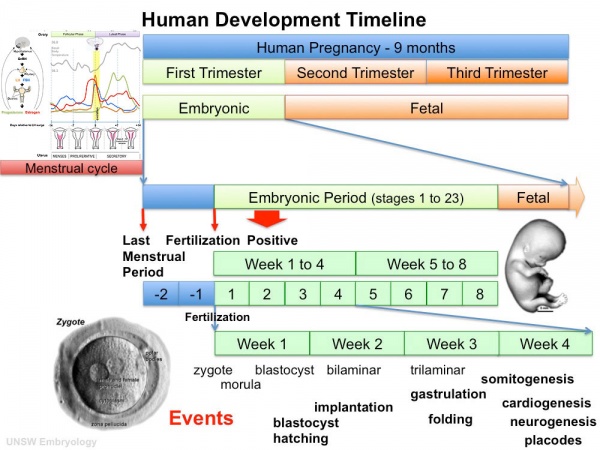ANAT2341 Lab 2: Difference between revisions
From Embryology
mNo edit summary |
mNo edit summary |
||
| Line 17: | Line 17: | ||
|} | |} | ||
===Recent Article=== | |||
<pubmed>26254468</pubmed> | <pubmed>26254468</pubmed> | ||
:"Growth differentiation factor 9 (GDF9) and bone morphogenetic protein 15 (BMP15) are oocyte-specific growth factors with central roles in mammalian reproduction, regulating species-specific fecundity, ovarian follicular somatic cell differentiation and oocyte quality. In the human, GDF9 is produced in a latent form, the mechanism of activation being an open question. Here, we produced a range of recombinant GDF9 and BMP15 variants, examined their in silico and physical interactions, and their effects on ovarian [[Granulosa Cells|granulosa cells]] (GC) and oocytes. We found that the potent synergistic actions of GDF9 and BMP15 on GC can be attributed to the formation of a heterodimer, which we have termed cumulin. Structural modelling of cumulin revealed a dimerization interface identical to homodimeric GDF9 and BMP15, indicating likely formation of a stable complex. This was confirmed by generation of recombinant heterodimeric complexes of pro/mature domains (pro-cumulin) and covalent mature domains (cumulin). Both pro-cumulin and cumulin exhibited highly potent bioactivity on GC, activating both SMAD2/3 and SMAD1/5/8 signaling pathways, and promoting proliferation and expression of a set of genes associated with oocyte-regulated GC differentiation. Cumulin was more potent than pro-cumulin, pro-GDF9, pro-BMP15 or the two combined on GC. However, on cumulus-oocyte complexes, pro-cumulin was more effective than all other growth factors at notably improving oocyte quality as assessed by subsequent day 7 embryo development. Our results support a model of activation for human GDF9 dependant on cumulin formation through heterodimerization with BMP15. Oocyte-secreted cumulin is likely to be a central regulator of fertility in mono-ovular mammals." | |||
:'''OMIM Links:''' [http://omim.org/entry/601918 GDF9] | [http://omim.org/entry/300247 BMP15] | [http://omim.org/entry/601366 SMAD2] | |||
==Objectives== | ==Objectives== | ||
Revision as of 12:43, 13 August 2015
Week 1 to 3 Development
| ANAT2341 Lab 2: Introduction | Fertilization | Week 1 | Week 2 | Online Assessment | Group Project |
Oocyte Biology Research Unit
| Associate Professor Robert Gilchrist |
|---|
| Talk - The Reproductive Technology Revolution |
| Dr Gilchrist’s primary research interests are in the regulation of mammalian oocyte development and maturation, and the development of novel oocyte maturation techniques for infertility treatment. |
| UNSW Research Gateway - PubMed |
Recent Article
<pubmed>26254468</pubmed>
- "Growth differentiation factor 9 (GDF9) and bone morphogenetic protein 15 (BMP15) are oocyte-specific growth factors with central roles in mammalian reproduction, regulating species-specific fecundity, ovarian follicular somatic cell differentiation and oocyte quality. In the human, GDF9 is produced in a latent form, the mechanism of activation being an open question. Here, we produced a range of recombinant GDF9 and BMP15 variants, examined their in silico and physical interactions, and their effects on ovarian granulosa cells (GC) and oocytes. We found that the potent synergistic actions of GDF9 and BMP15 on GC can be attributed to the formation of a heterodimer, which we have termed cumulin. Structural modelling of cumulin revealed a dimerization interface identical to homodimeric GDF9 and BMP15, indicating likely formation of a stable complex. This was confirmed by generation of recombinant heterodimeric complexes of pro/mature domains (pro-cumulin) and covalent mature domains (cumulin). Both pro-cumulin and cumulin exhibited highly potent bioactivity on GC, activating both SMAD2/3 and SMAD1/5/8 signaling pathways, and promoting proliferation and expression of a set of genes associated with oocyte-regulated GC differentiation. Cumulin was more potent than pro-cumulin, pro-GDF9, pro-BMP15 or the two combined on GC. However, on cumulus-oocyte complexes, pro-cumulin was more effective than all other growth factors at notably improving oocyte quality as assessed by subsequent day 7 embryo development. Our results support a model of activation for human GDF9 dependant on cumulin formation through heterodimerization with BMP15. Oocyte-secreted cumulin is likely to be a central regulator of fertility in mono-ovular mammals."
Objectives
- Identify the key features of fertilization.
- Identify the key features of week 1 development.
- Identify the key features of week 2 development.
- Complete the individual assessment 2.
- Group assessment project.
Fertilization Reviews
- Review of sperm penetration through cumulus mass and zona pellucida
- Review of sperm-egg interaction
- Review of parthenogenesis
Human development timeline
| ANAT2341 Lab 2: Introduction | Fertilization | Week 1 | Week 2 | Online Assessment | Group Project |
- 2015 Course: Week 2 Lecture 1 Lecture 2 Lab 1 | Week 3 Lecture 3 Lecture 4 Lab 2 | Week 4 Lecture 5 Lecture 6 Lab 3 | Week 5 Lecture 7 Lecture 8 Lab 4 | Week 6 Lecture 9 Lecture 10 Lab 5 | Week 7 Lecture 11 Lecture 12 Lab 6 | Week 8 Lecture 13 Lecture 14 Lab 7 | Week 9 Lecture 15 Lecture 16 Lab 8 | Week 10 Lecture 17 Lecture 18 Lab 9 | Week 11 Lecture 19 Lecture 20 Lab 10 | Week 12 Lecture 21 Lecture 22 Lab 11 | Week 13 Lecture 23 Lecture 24 Lab 12 | 2015 Projects: Three Person Embryos | Ovarian Hyper-stimulation Syndrome | Polycystic Ovarian Syndrome | Male Infertility | Oncofertility | Preimplantation Genetic Diagnosis | Students | Student Designed Quiz Questions | Moodle page

